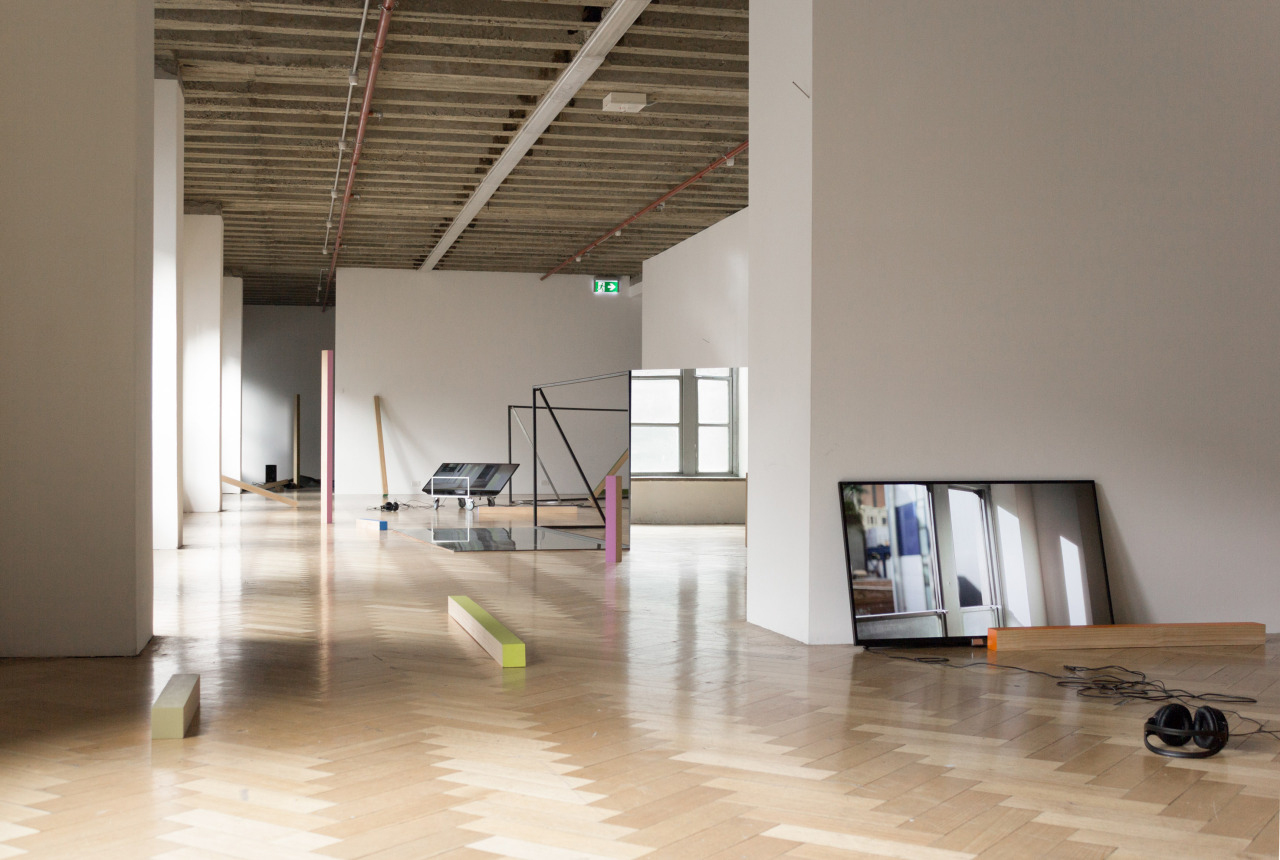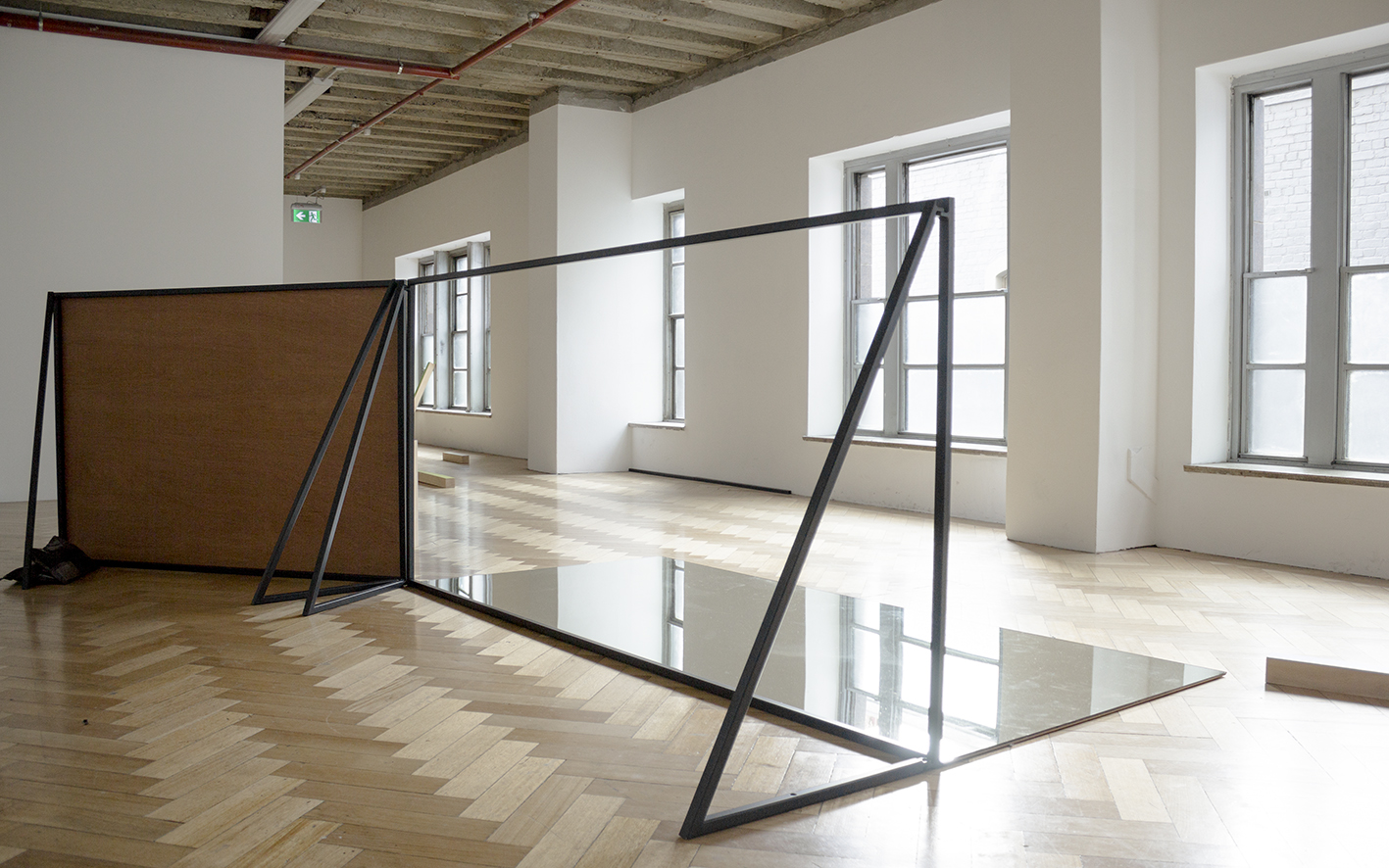THREE ADJOINING SPACES WITH MANIFOLD EDGES, 2015
multiple video recordings of site with diegetic sound (duration variable), steel, mirror, rubber matting, gallery windows, window latches, shot bags, strapping, plastic sheeting, nails, tape, casters, Sony Bravia screens, intermittent performances.
at: West Space, Naarm Melboune, curated by Liang Luscomb
multiple video recordings of site with diegetic sound (duration variable), steel, mirror, rubber matting, gallery windows, window latches, shot bags, strapping, plastic sheeting, nails, tape, casters, Sony Bravia screens, intermittent performances.
at: West Space, Naarm Melboune, curated by Liang Luscomb
This project was re-installed intermittently through a 5-week exhibition duration, developed as solo exhibition alongside Geoff Robinson’s separate solo exhibition for the same gallery spaces
The objects of Geoff Robinson are visible in this documentation
The objects of Geoff Robinson are visible in this documentation




From Elena Betros’ exhibition text:
A system, a frame to look through.
An LCD screen rests on a low steel wheel- able platform. The video depicts the space in a past time, a different configuration. This video whose duration is variable and accumulative showed a looped sequence of still interior shots at undetermined moments of its configuration. Movement comes from the sound, the sound of stuff and people moving inside of the gallery. The plastic sheets, transparent and black, moving in the breeze from the open windows, are discursive and spontaneous, more bodily than the framings around them. The sound of bodies in the videos invites my body to move around the gallery. The ambient sound of the street is also contained in the headphones and mirrors the sounds heard before. Shadows on the wall in another shot show that time has passed; their position has changed. A body unseen interrupts with its own shadow as it passes through the gallery. A piece of tape swings. Unsurprisingly Grogan casually enters to place a plinth in frame, just for a second, adjusts and leaves again.
Simultaneity of structure and looseness.
As in Jeanne Dielman and News from Home, the use of a fixed shot is also employed within the video on the LCD screen in THREE ADJOINING SPACES WITH MANIFOLD EDGES. Similarly, West Space’s Front Space, Gallery 1 and Back Space contained the exhibition and its edges, the in-frame and the out-of-frame. (Robinson’s exhibition simultaneously occupied these manifold edges and whilst each exhibition existed separately they also framed and informed one another.) My path through the galleries was partly determined by the positions of sculptural and spatial framings which acted as devices to frame my perspective of the interior and exterior of the gallery. I was also framed by them — this framing also constantly shifting. Here there is simultaneity of structure and looseness with any given day or moment allowing multiple paths, movements through, perceptions, perspectives, new observations and encounters within these malleable structures. In THREE ADJOINING SPACES WITH MANIFOLD EDGES the frames within the exhibition continually lay down organizational structures for potential ways of viewing or being framed within the gallery. It is in this strategy that Grogan sits somewhere between Akerman’s two films, expressing a need for structure but also chance and spontaneity.
Akerman describes Jeanne Dielman as ‘really what I saw as a child, my mother and her aunts and the way they organised their lives; it’s so they didn’t have any hole in their life so they didn’t have the time to feel too much’.5 Just as a window is a structure that frames a view of the exterior — an exterior that is inevitably subject to continual change, frames — structure and organisation can act as a mechanism to stabilise and secure the day-to-day. Framing could also be a frame of mind, a philosophy, a set of ethics within which to live and locate one’s life through.
Details of the wooden parquetry are blocked out by black rubber flooring that is half rolled out, dirty, its black capturing innumerable overlaid footprints. Free- standing steel structures, one holding a mirror with clamps, resemble a film screen or an empty billboard and frame views of the gallery’s architecture. The windows, usually closed and opaque, are now open and frame exterior perspectives; window frames, some blocked in with dirty insulation folded and fibrous, domestic views of a stranger’s house, a white t-shirt hangs, perspectives of the city, windows, skyscrapers, an apartment building, a palm tree sways. All are framing and re-framing depending on your position and proximity; sometimes your own body is reflected within a mirror’s frame or the window of the stranger’s house. Square shadows on the white walls shift, determined by the time of day.
A system, a frame to look through.
An LCD screen rests on a low steel wheel- able platform. The video depicts the space in a past time, a different configuration. This video whose duration is variable and accumulative showed a looped sequence of still interior shots at undetermined moments of its configuration. Movement comes from the sound, the sound of stuff and people moving inside of the gallery. The plastic sheets, transparent and black, moving in the breeze from the open windows, are discursive and spontaneous, more bodily than the framings around them. The sound of bodies in the videos invites my body to move around the gallery. The ambient sound of the street is also contained in the headphones and mirrors the sounds heard before. Shadows on the wall in another shot show that time has passed; their position has changed. A body unseen interrupts with its own shadow as it passes through the gallery. A piece of tape swings. Unsurprisingly Grogan casually enters to place a plinth in frame, just for a second, adjusts and leaves again.
Simultaneity of structure and looseness.
As in Jeanne Dielman and News from Home, the use of a fixed shot is also employed within the video on the LCD screen in THREE ADJOINING SPACES WITH MANIFOLD EDGES. Similarly, West Space’s Front Space, Gallery 1 and Back Space contained the exhibition and its edges, the in-frame and the out-of-frame. (Robinson’s exhibition simultaneously occupied these manifold edges and whilst each exhibition existed separately they also framed and informed one another.) My path through the galleries was partly determined by the positions of sculptural and spatial framings which acted as devices to frame my perspective of the interior and exterior of the gallery. I was also framed by them — this framing also constantly shifting. Here there is simultaneity of structure and looseness with any given day or moment allowing multiple paths, movements through, perceptions, perspectives, new observations and encounters within these malleable structures. In THREE ADJOINING SPACES WITH MANIFOLD EDGES the frames within the exhibition continually lay down organizational structures for potential ways of viewing or being framed within the gallery. It is in this strategy that Grogan sits somewhere between Akerman’s two films, expressing a need for structure but also chance and spontaneity.
Akerman describes Jeanne Dielman as ‘really what I saw as a child, my mother and her aunts and the way they organised their lives; it’s so they didn’t have any hole in their life so they didn’t have the time to feel too much’.5 Just as a window is a structure that frames a view of the exterior — an exterior that is inevitably subject to continual change, frames — structure and organisation can act as a mechanism to stabilise and secure the day-to-day. Framing could also be a frame of mind, a philosophy, a set of ethics within which to live and locate one’s life through.
Details of the wooden parquetry are blocked out by black rubber flooring that is half rolled out, dirty, its black capturing innumerable overlaid footprints. Free- standing steel structures, one holding a mirror with clamps, resemble a film screen or an empty billboard and frame views of the gallery’s architecture. The windows, usually closed and opaque, are now open and frame exterior perspectives; window frames, some blocked in with dirty insulation folded and fibrous, domestic views of a stranger’s house, a white t-shirt hangs, perspectives of the city, windows, skyscrapers, an apartment building, a palm tree sways. All are framing and re-framing depending on your position and proximity; sometimes your own body is reflected within a mirror’s frame or the window of the stranger’s house. Square shadows on the white walls shift, determined by the time of day.
From Emily Castle’s critical essay for UnMagazine:
Helen Grogan’s THREE ADJOINING SPACES WITH MANIFOLD EDGES (29 May – 4 July) spanned three galleries and included a shifting field of sculptural elements: steel frames, black floor matting, draped plastic sheets, a large mirror, and the gallery windows — usually closed and opaque, now open. Propped against the wall or on a trolley, two video monitors displayed long takes of the subtle shifts in light and shade across the gallery space and adjacent city buildings.
Across their specific materials and methods, (the phases of the project) ...rearticulate the space of the gallery as a site of process, plurality and what writer Sarinah Masukor terms an ‘embodied observation’, working to ‘direct the viewer to elements of space that frequently go unnoticed’. By attuning our perception to the shifts occurring in and across the architecture, the artworks reveal that the gallery space cannot be figured as the passive or static backdrop to the activity of art, but is itself a material constantly in process. In addition to continually altering and reinstalling the physical components of the work, the artist aims to remain open to the dynamic interplay and agency of a multiplicity of objects and nonhuman forces; among which the viewer is figured as an active and embodied participant. Given these ongoing changes, the document in its various forms is key to how the work is accessed, and is actively enfolded into the present experience of the project. The accumulation of these gestures can be thought of as forming a certain type of orientation. The effect of their repetition orientates us, artists and viewers alike, toward particular ways of inhabiting and attending to space.
Helen Grogan’s THREE ADJOINING SPACES WITH MANIFOLD EDGES (29 May – 4 July) spanned three galleries and included a shifting field of sculptural elements: steel frames, black floor matting, draped plastic sheets, a large mirror, and the gallery windows — usually closed and opaque, now open. Propped against the wall or on a trolley, two video monitors displayed long takes of the subtle shifts in light and shade across the gallery space and adjacent city buildings.
Across their specific materials and methods, (the phases of the project) ...rearticulate the space of the gallery as a site of process, plurality and what writer Sarinah Masukor terms an ‘embodied observation’, working to ‘direct the viewer to elements of space that frequently go unnoticed’. By attuning our perception to the shifts occurring in and across the architecture, the artworks reveal that the gallery space cannot be figured as the passive or static backdrop to the activity of art, but is itself a material constantly in process. In addition to continually altering and reinstalling the physical components of the work, the artist aims to remain open to the dynamic interplay and agency of a multiplicity of objects and nonhuman forces; among which the viewer is figured as an active and embodied participant. Given these ongoing changes, the document in its various forms is key to how the work is accessed, and is actively enfolded into the present experience of the project. The accumulation of these gestures can be thought of as forming a certain type of orientation. The effect of their repetition orientates us, artists and viewers alike, toward particular ways of inhabiting and attending to space.